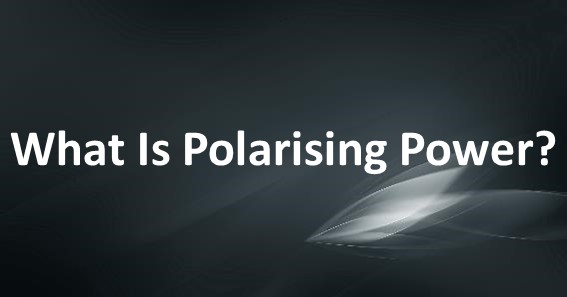Are you curious to know what is polarising power? You have come to the right place as I am going to tell you everything about polarising power in a very simple explanation. Without further discussion let’s begin to know what is polarising power?
In the realm of chemistry, certain concepts wield a profound influence on the behavior and properties of molecules, shaping the course of reactions and interactions. Polarizing power is one such concept, a fundamental aspect that governs the ability of an atom to distort the electron cloud of another atom. Join us as we embark on a journey into the world of polarizing power, unraveling its significance, factors, and the role it plays in determining the reactivity and chemical behavior of substances.
What Is Polarising Power?
Polarizing power refers to the ability of an atom, usually a cation (positively charged ion), to attract and distort the electron cloud of another atom or ion, typically an anion (negatively charged ion). This phenomenon is at the heart of chemical interactions, influencing the formation of chemical bonds, molecular shapes, and the reactivity of compounds.
Factors Influencing Polarizing Power
- Ionic Charge: The magnitude of the charge on the cation greatly affects its polarizing power. Higher positive charges result in greater polarizing power, as the stronger positive charge attracts and distorts the electron cloud of the anion more effectively.
- Size of Ions: Smaller ions have higher polarizing power compared to larger ions. Smaller cations can get closer to the anion’s electron cloud, leading to stronger distortion.
- Electron Configuration: The electron configuration of the cation plays a role in determining its polarizing power. Cations with a higher effective nuclear charge (more protons relative to electrons) tend to exhibit greater polarizing power.
Significance Of Polarizing Power
- Formation of Ionic Bonds: In ionic compounds, polarizing power affects the strength and stability of the ionic bonds between cations and anions. Higher polarizing power can lead to more tightly held electrons and stronger bonds.
- Covalent Character: Polarizing power contributes to the covalent character of certain ionic compounds. When the electron cloud of an anion is significantly distorted by a cation, the bond between them may have characteristics of both ionic and covalent bonding.
- Reaction Rates: In chemical reactions, polarizing power can influence the rate of reaction by affecting the ease with which bonds are broken and formed.
- Complex Formation: Polarizing power is essential in the formation of coordination complexes, where transition metal ions attract and coordinate with ligands.
Real-World Applications
- Catalysis: Polarizing power is crucial in catalytic processes, where certain ions or compounds act as catalysts by polarizing reactants and facilitating chemical reactions.
- Solubility and Precipitation: Polarizing power plays a role in determining the solubility of salts and the formation of insoluble precipitates.
- Biological Reactions: Polarizing power influences the interactions between ions and molecules in biological systems, affecting processes such as enzyme activity and protein-ligand binding.
Conclusion
Polarizing power is a captivating concept that underpins numerous chemical phenomena, shaping the behavior and properties of compounds and ions. By understanding the factors that influence polarizing power and its implications for chemical interactions, scientists and researchers can unravel the intricate mechanisms that drive reactions, reactions, and transformations in the world of chemistry. As we continue to delve deeper into the realm of molecular interactions, the concept of polarizing power remains a powerful tool for deciphering the intricate dance of atoms and electrons that defines the world of chemistry.
FAQ
What Is The Polarization Power?
The ability of a cation to distort the electron density of anion towards itself or we can say that ability of cation to pull the electron density of anion towards itself is known as Polarizing power. And the tendency by which the anion undergoes polarization is known as Polarizability.
What Is Polarizing Power With Example?
The ability of a cation to distort an anion is known as its polarization power and the tendency of the anion to become polarized by the cation is known as its polarizability.
What Is Polarization Class 11?
Polarisation is the distortion of a negatively charged ion’s electron cloud by a positively charged ion. The molecule has a dipole moment because of polarisation.
What Is Polarization And Polarization Power?
The presence of a cation distorts the electron cloud of an anion. This is known as polarisation. And the tendency of a cation to do so is termed as polarising power of the cation. That end of the electron cloud of anion, which is towards the cation, becomes relatively more negative than the end away from it.
I Have Covered All The Following Queries And Topics In The Above Article
What Is Polarising Power Of Cation
What Is Meant By Polarising Power Of A Cation
What Is Polarising Power In Chemistry
What Is Polarising Power
What is Polarising power in simple words
What is polarizing power?

